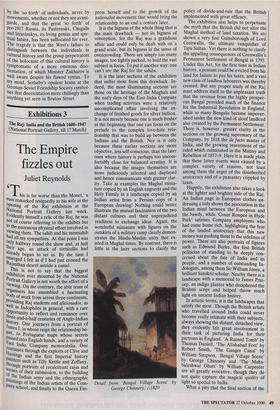Russian art
The return of the Itinerants
Andrei Navrozov reflects on the promotion of Soviet art in the West It will serve further development of cultural links and strengthening of under- standing between people.' This insight into the role of Russian art, original if syntacti- cally imperfect, was proudly ascribed to `Mr Vasilly [sic] Zakharov, USSR Minister of Culture' by Sotheby's (or Sotbis, as they are content to be known in the alphabet robbed of its theta by government decree in 1917) on the occasion of their 'historic' auction held in Moscow on 7 July 1988.
Historic it was, and history was repeat- ing itself as usual, with the Soviets ushering in an updated version of the New Econo- mic Policy of the early 1920s. Admittedly, the current simulacrum of economic and political liberties is a faint echo of its predecessor, in recognition of whose permanence the West first rushed in to build Stalin's tanks and bombers: in 1922, for instance, in Moscow alone there were 143 registered publishing houses in private hands. But the criteria by which freedom not to mention cultural pluralism — is measured have become looser over the years, a fact not lost on Soviet propagan- dists. So all went well, Sotheby's took in US$3,586,286 at the sale and have since opened up shop in Unter den Linden. A surprise telephone call from the German- Soviet Friendship Society was instrumental in securing the premises. The question of how culture, and art in particular, has fitted in with Soviet strategy ever since 8 April 1918, when Lenin ordered his 'commissar for enlightenment' to follow the plan set out in Tommaso Campanella's City of the Sun by decorating the fronts of houses with instructive fres- coes, is perhaps broader, and more vital, than the question of how the West has failed to discriminate between the fake and the real, the export icon and the conse- crated image. Yet this narrower question is no less fascinating. Consider the Roy Miles phenomenon. Angie, who cuts the hair on many Sotheby's department heads as well as my own, has never heard of Roy Miles, who is reported to have begun his artistic career as the owner of a hairdressing salon. 'But that was a different generation,' she mused charitably from her Grosvenor Square salon. Still, few people with even a margin- al interest in such matters have escaped the honour of an invitation to visit the opulent Roy Miles Gallery in Bruton Street, issued in person, by post or in opulent magazine advertisements by the opulent Roy Miles himself. Martin Summers of Lefevre, which sold Cezannes to Samuel Courtauld, is not impressed by the aggregate opulence of their new neighbour, advertising 'The Largest Stock of Russian Art in London'. But even he is not cynical enough to stop thinking that, after all, the artists them- selves are hardly to blame for the noise next door. So all goes well, and HRH the Prince of Wales is photographed with Roy Miles.
The gallery sells what Peter Watson, writing in the Observer, vaguely described as 'figurative, colourful pictures produced during the 70 years when Russia was a closed country', not to be confused with `the small, specialised market for the avant-garde paintings of Rodchenko, Popova and so forth'. That `so forth' makes all the difference, and a brief history of Russian culture in this century is necessary to remind the reader why.
Thirty years ago, on reading Pasternak's Doctor Zhivago, the émigré Igor Stravin- sky wrote in his diary: 'This is real Itineran- cy [peredvizhnichestvo].' He was referring to the Itinerants, a group of painters which dominated the scene in Russia at the turn of the century and is best imagined as a paint-and-canvas hypostasis of Tolstoy's idea of art. Since Pasternak's father had belonged to the group and was one of Tolstoy's favourite painters, Stravinsky's irony delineated the contours of cultural regression within one family.
With Stalin's progress from covert to overt dictatorship, the avant-garde 'and so forth', which had opposed the Itinerant establishment before 1917 and had become the establishment thereafter, was doomed: Stalin's imperial vision would revive Rus- sian chauvinism, Orthodox Christianity and yes, Tolstoy, in a jubilee edition of a hundred gilt-edged volumes. The cultural perestroika of April 1932 was a nationalist purge of the 'avant-garde' which had, during the previous 15 years of credal internationalism, proven itself infinitely more tyrannical than any pre-1917 'estab- lishment': quite simply, men like Mayakovsky or Rodchenko wanted the `Itinerants 'and so forth' shipped off to Solovki. Now, however, it was their turn to be shipped off to places even less habit- able, while the old academics would be- come, once again, the establishment.
Most of the art offered to the West, with the blessing of the Soviet Ministry of Culture, is the third, or at best second, generation — please bear with me — of forced (`Socialist) imitations of free (Itinerant') imitations of Western 19th- century (`Realist) originals. Is that a travesty or a tragedy?
Perhaps both. The travesty is that art, like everything of spiritual value, is made `The Steelworkers' Lunch', 1961, by Georgy Satel: one of the star attractions at the Roy Miles Gallery by the 'so forth' of individuals, never by movements, whether or not they are avant- garde, and that the great 'so forth' of pre-1917 Russia, its Pasternaks, Chagalls and Stravinskys, its living genius and spir- itual future, has been suffocated for ever. The tragedy is that the West's failure to distinguish between the individuals in Cultural history and the group perpetrators of the holocaust of tliat cultural history is symptomatic of a more ominous diso- rientation, of which Minister Zakharov is well aware despite his flawed syntax. To my mind, Sotheby's opulent home at the German-Soviet Friendship Society symbol- ises that disorientation more chillingly than anything yet seen in Bruton Street.



































































 Previous page
Previous page